LECTURE 1-CELL COMMUNICATION AND SIGNALING
1/51
There's no tags or description
Looks like no tags are added yet.
Name | Mastery | Learn | Test | Matching | Spaced |
|---|
No study sessions yet.
52 Terms
Overview: Cell Communication and signaling
1) Discuss multiple mechanisms of cell communication
2) Understand how extracellular signals are converted to intracellular signals
3) Unique signaling pathways lead to diverse cellular responses
4) Signaling in development and how defects in signaling pathways lead to cancer (the RAS pathway)
Cell Communication
cells communicate through a large variety of extracellular signals
cells must interpret these signals that they receive from other cells to help coordinate their behaviors
information can come in a variety of forms: cellular communication involves converting those signals from one form to another
This process of conversion is called signal transduction
Signal transduction involves converting extracellular signals to intracellular signals
Signal Transduction elicits a specific cellular response- changes in gene expression, protein expression, morphological changes, etc.

General principles of cell signaling
typical communication between cells; the signaling cell produces a signal molecule that is detected by a target cell
target cells have receptor proteins that recognize and respond to the signal molecule
signal transduction begins when the receptor protein on the target cell receives an incoming extracellular signal and converts it to an intracellular signal
Extracellular signal molecules stimulate a target cell by binding to its receptor proteins, including intracellular and cell-surface receptors

Signal Transduction relays outside signals to effect intracellular responses
Extracellular signals can act slowly or rapidly
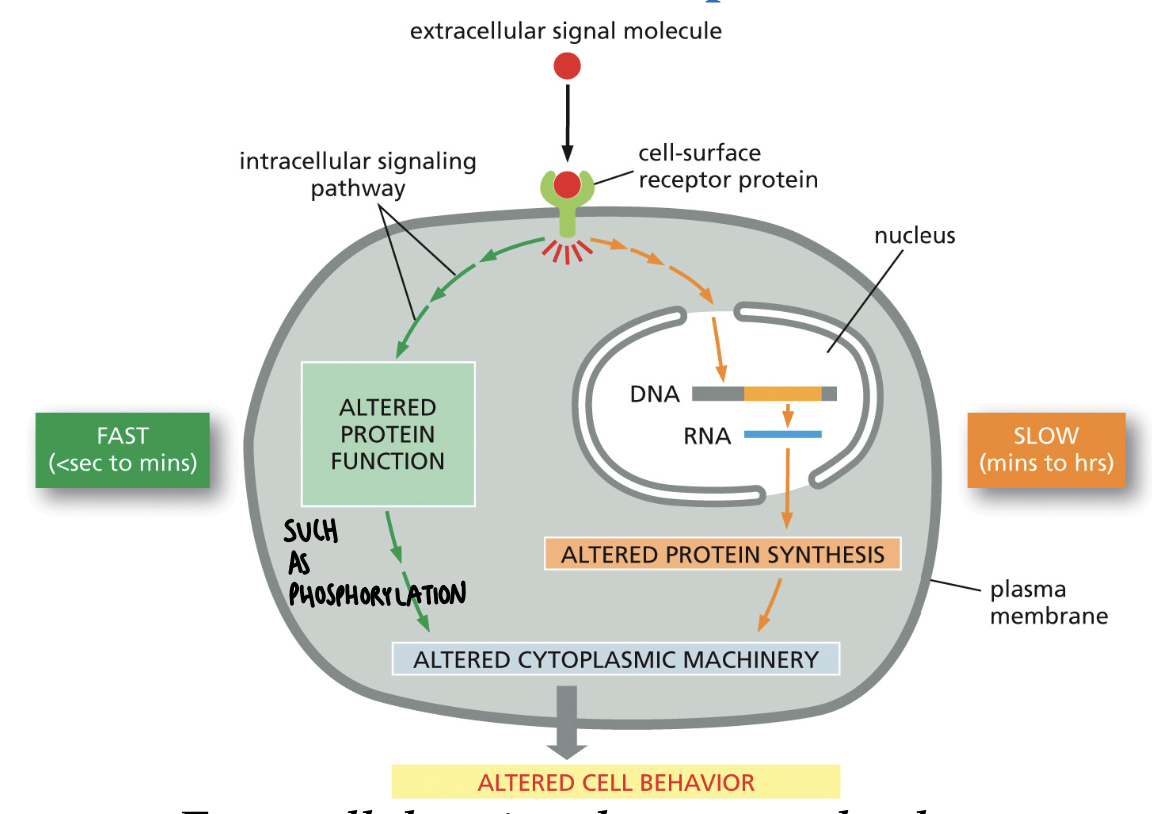
OH: fast cause already made proteins bind and phosphorylate
OH: Slow cause proteins need to be made and transcription and translation need to occur
Modes of Cell communication
endocrine (estrogen, insulin)-long range signal
Paracrine (egf, bmp, wnt)-texting a friend, closed environment
Neuronal (acetylcholine, GABA)-through neuron structures, can happen fast, left leg moving
Contact-dependent (delta-notch)-saying a secret
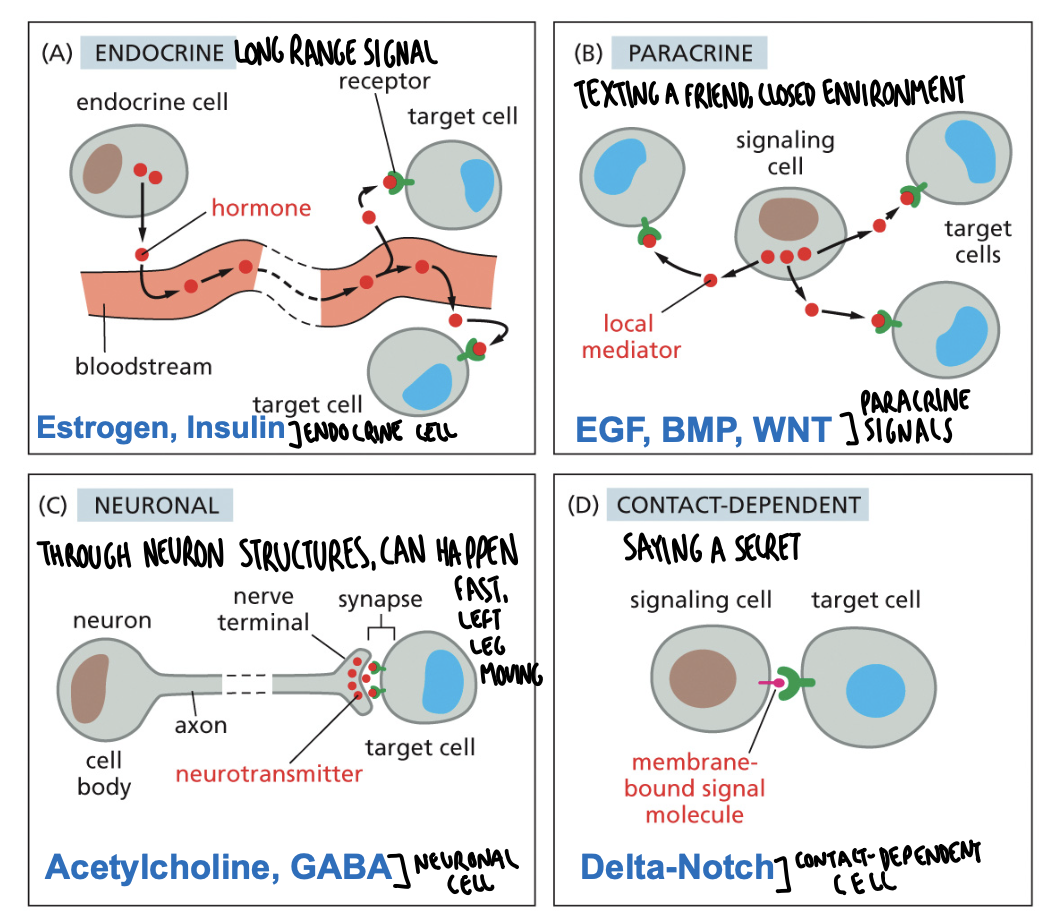
Endocrine signaling
long range peptide or steroid hormones (signals) that are delivered through the circulatory system
endocrine: “public” style of communication
OH: this is because it reaches further and broadcasts away from the nearby cells
broadcasts a signal (hormones) throughout the whole body through secretion into the bloodstream (animal cells)
cells that produce hormones are endocrine cells
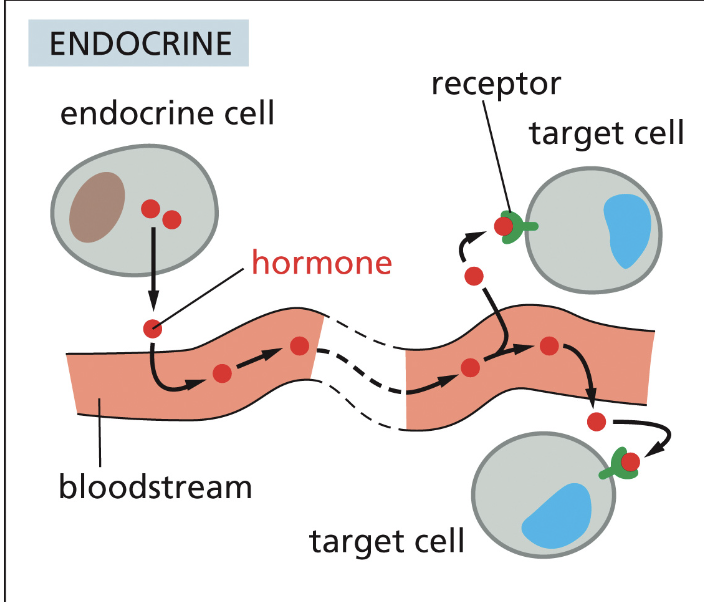
Endocrine signaling: long range peptide or steroid hormones (signals) that are delivered through the circulatory system
Adrenaline (epinephrine)-hormone, produced by adrenal gland, derivative of the amino acid tyrosine, increases blood pressure, heart rate and metabolism
Insulin, peptide hormone, produced by beta cells of pancreas, protein, stimulates glucose uptake, protein synthesis, and lipid synthesis in various cell types
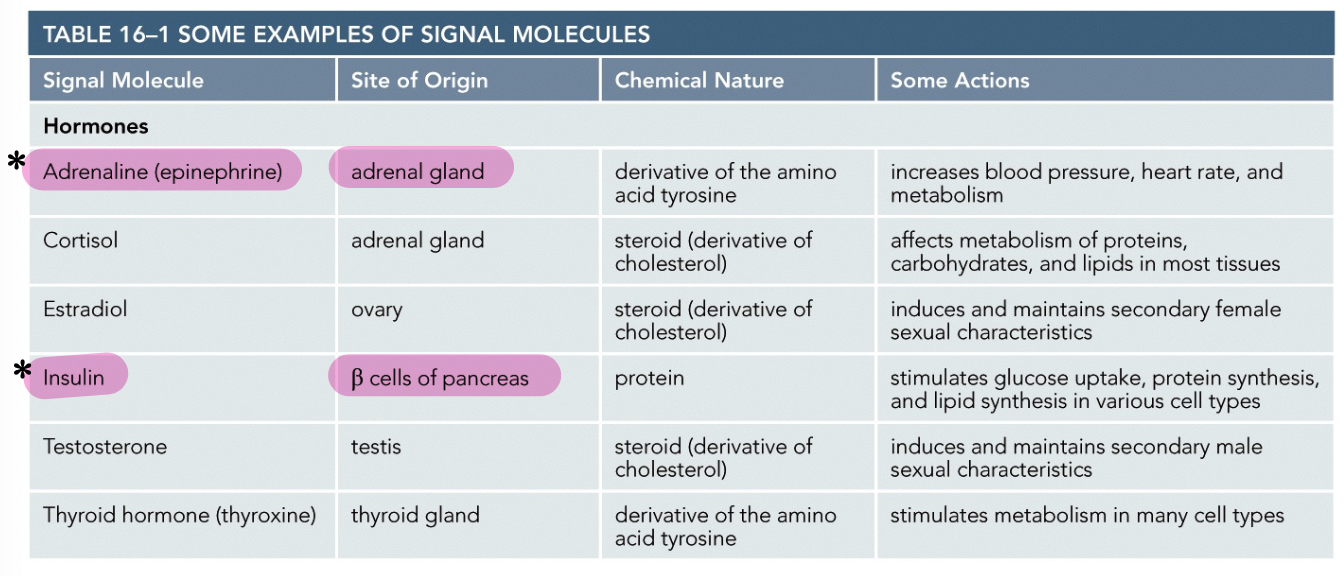
Example of Endocrine Signaling impact on human development
the pituitary gland is an endocrine gland that produces multiple hormones that regulate many different organs in the body
excess growth hormone leads to acromegalia

Neuronal Signaling
long range transmitted along axons to far away target cells
Neurotransmitters
acetylcholine, nerve terminals, derivative of choline, excitatory neurotransmitter at many nerve-muscle synapses and in central nervous system
y-aminobutyric acid (GABA), nerve terminals, derivative of the amino acid glutamic acid, inhibitory neurotransmitter in central nervous system
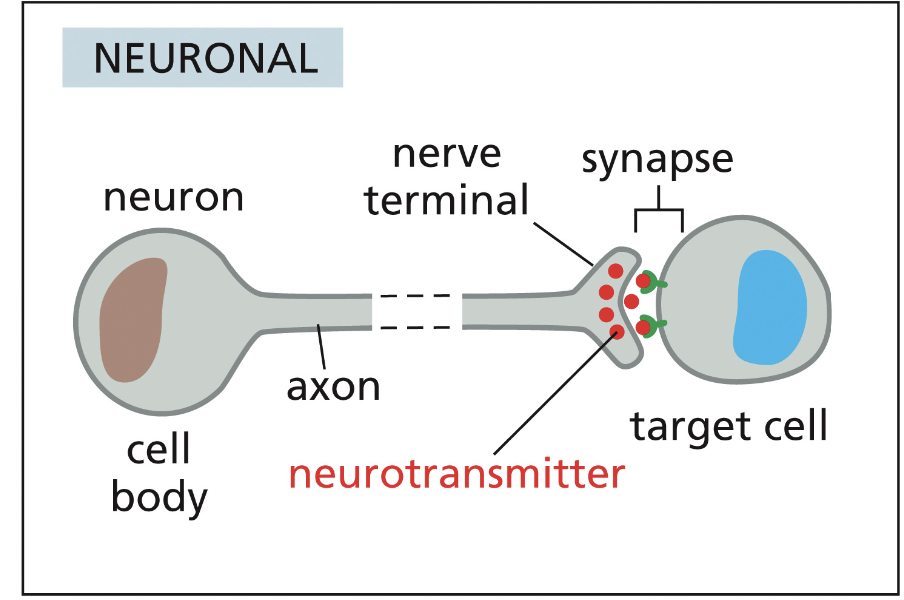
Neuronal signaling: long range transmitted along axons to far away target cells
transmitted along axons to remote target cells
when action potentials reach the axon terminal, electrical signals get converted into chemical signals in the form of neurotransmitters
the neurotransmitter then diffuses across the synaptic gap to reach the membrane of the target cell

Calcium signaling
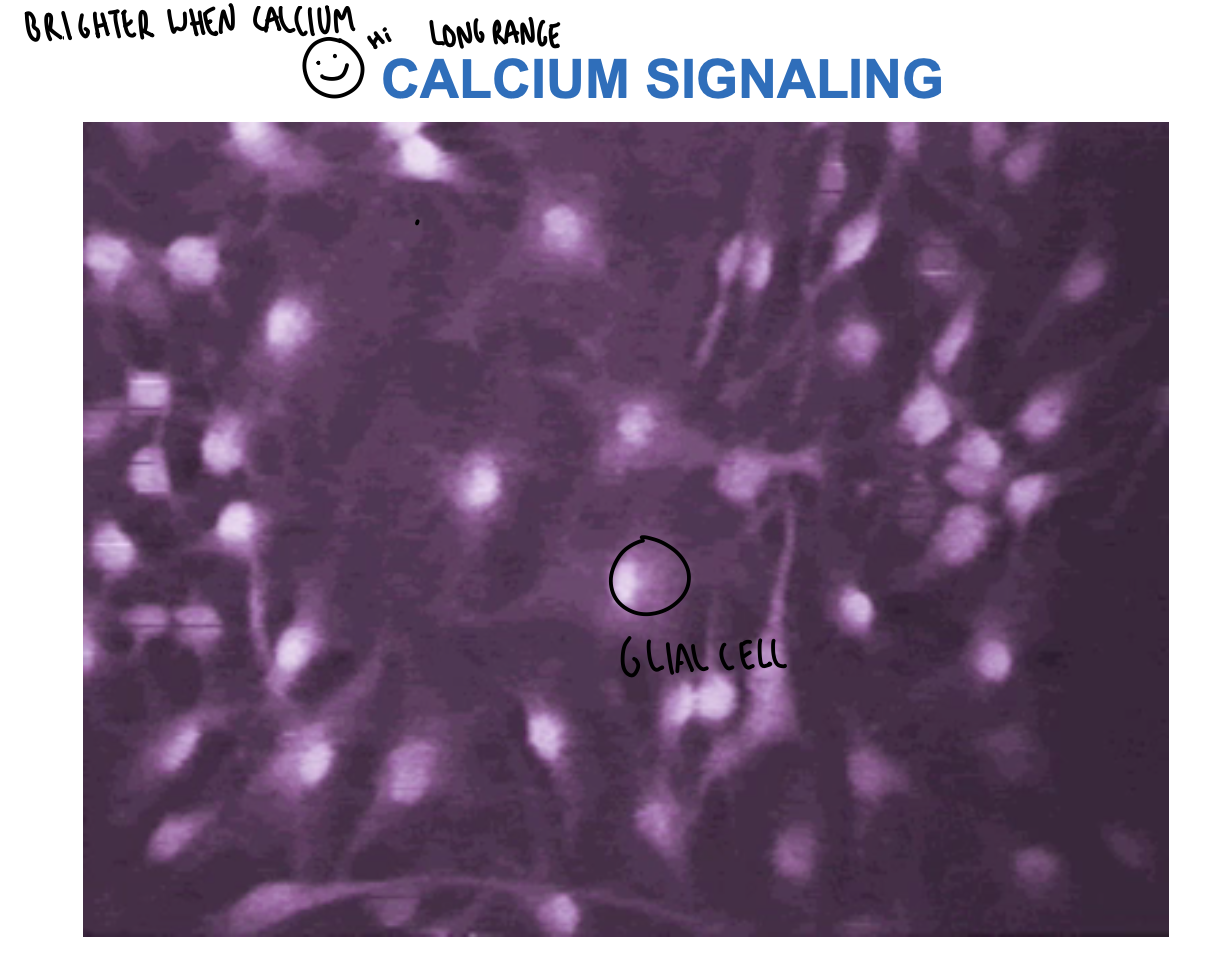
Paracrine signaling
short range signals released by neighboring cells that function locally
acts as a “local mediator”
signal molecules regulating the inflammatory response work in this manner
autocrine signaling-cells secrete factors that they express receptors for and stimulate their own growth or survival (i.e. cancer cells)
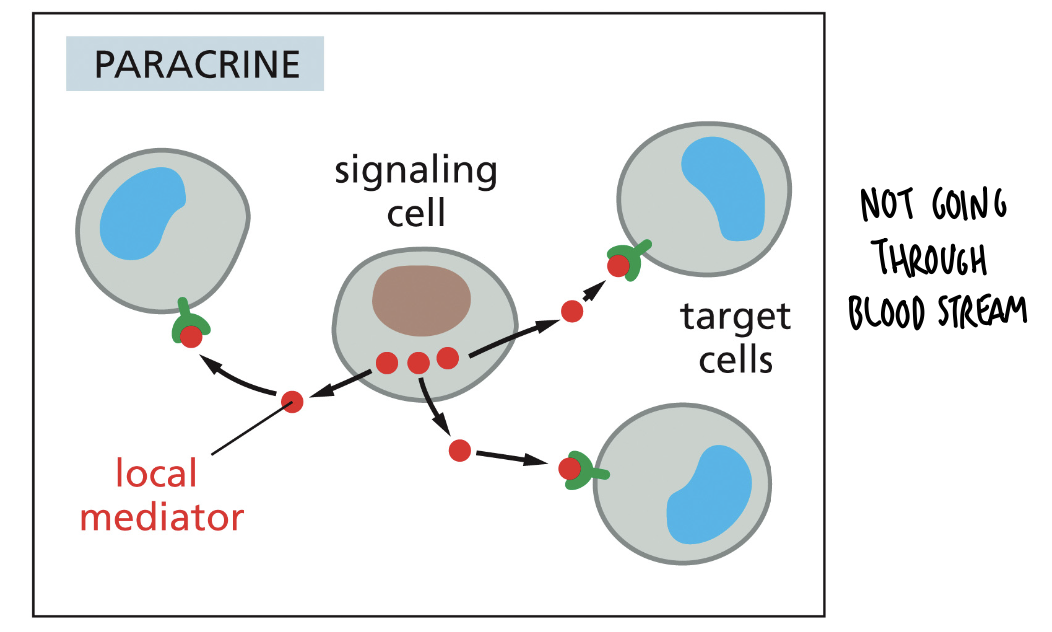
Paracrine signaling: short range signals released by neighboring cells that function locally
EGF-epidermal growth factor, a protein that stimulates cell proliferation
BMP-bone morphogenic protein, a protein that promotes differentiation
WNT-wingless and int-1, a protein that stimulates cell proliferation

Juxtacrine Signaling
needs cell to cell contact
transmembrane protein signaling between 2 neighboring cells
cell makes direct physical contact through signal molecules lodged in the plasma membrane of the signaling cell and receptor proteins embedded in the plasma membrane of the target cell
example: in embryonic development, contact-dependent signaling allows adjacent cells to become more specialized to form different cell types
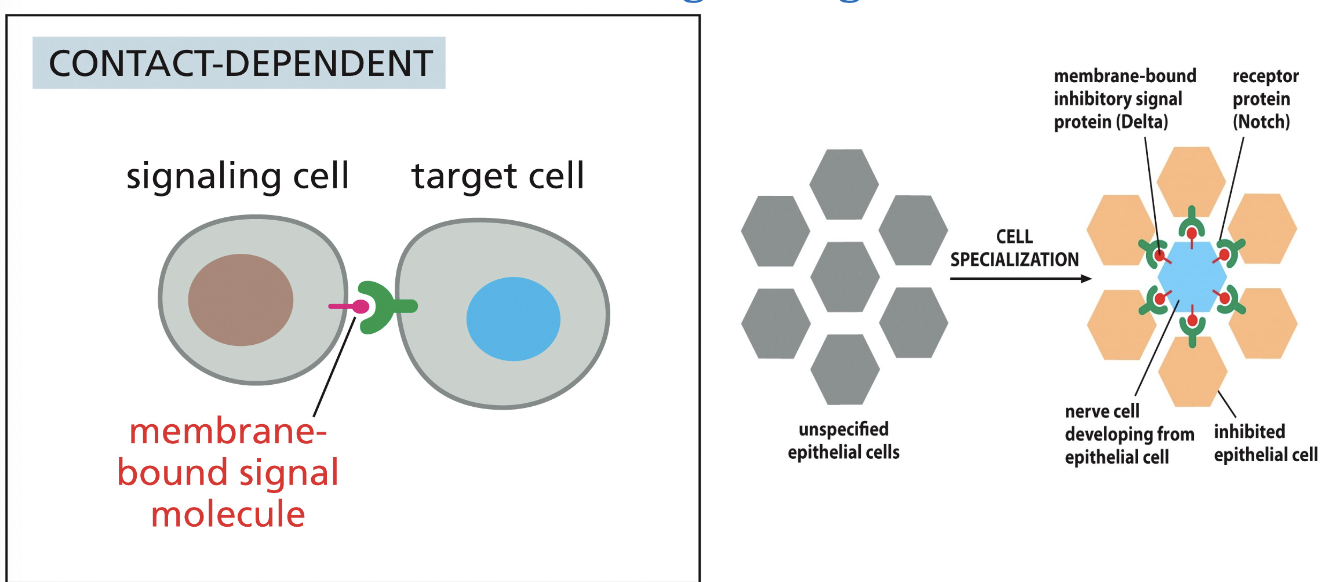
Juxtacrine signaling: Transmembrane protein signaling between 2 neighboring cells
notch receptor is a transcription factor
when the membrane-bound signal protein, Delta binds to its receptor, Notch, on a neighboring cell, the receptor is cleaved
The released part of the cytosolic tail of Notch migrates to the nucleus, where it activates Notch-responsive genes, such as genes that control nerve cell production in fruit fly
OH: Transcription of Notch-Responsive Genes which decide cell fate and stem cell maintenance
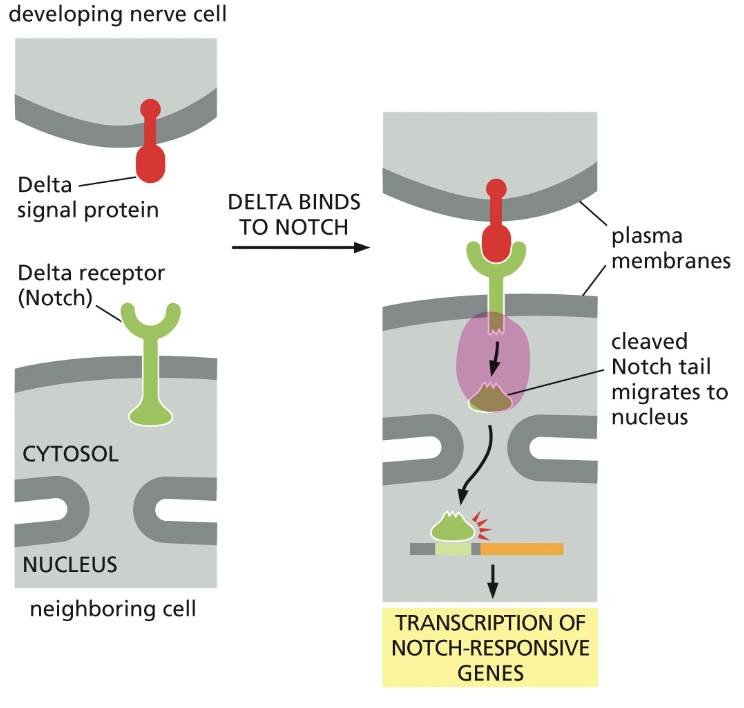

Extracellular signals can bind to…
cell-surface receptors or to intracellular enzymes or receptors
Extracellular signals fall into two categories:
1) those that are too large or too hydrophilic to cross the plasma membrane OR
2) those that are too small or hydrophobic enough to diffuse across the plasma membrane
Large and/or hydrophilic molecules must rely on membrane receptors to relay their message across the membrane
Small and/or hydrophobic molecules diffuse across the plasma membrane, and bind to intracellular enzymes or intracellular receptor proteins
Receptors for signals are found…
outside the cell
Signals: growth factors-EGF, peptide hormones-insulin, neurotransmitter-acetylcholine
Receptors: EGFR or ErbB1, insulin receptor (IR), nicotinic acetylcholine receptor
Large hydrophilic-extracellular signal molecule binds to cell-surface receptor protein that goes into the plasma membrane of the target cell and becomes an intracellular signaling molecule

Receptors for signals are found…
also inside the cell
steroid hormones-estrogen and cortisol
receptors-estrogen-cytoplasmic receptor and cortisol-cytoplasmic receptor
What is an example of a receptor located inside the cell that is translocated to the nucleus?
Cortisol!
goes through the plasma membrane and has conformational change which activates nuclear receptor protein, and the activated receptor-cortisol complex moves from the cytosol into the nucleus and the activated receptor-cortisol complex binds to regulatory region of target gene and activates transcription
slow process!
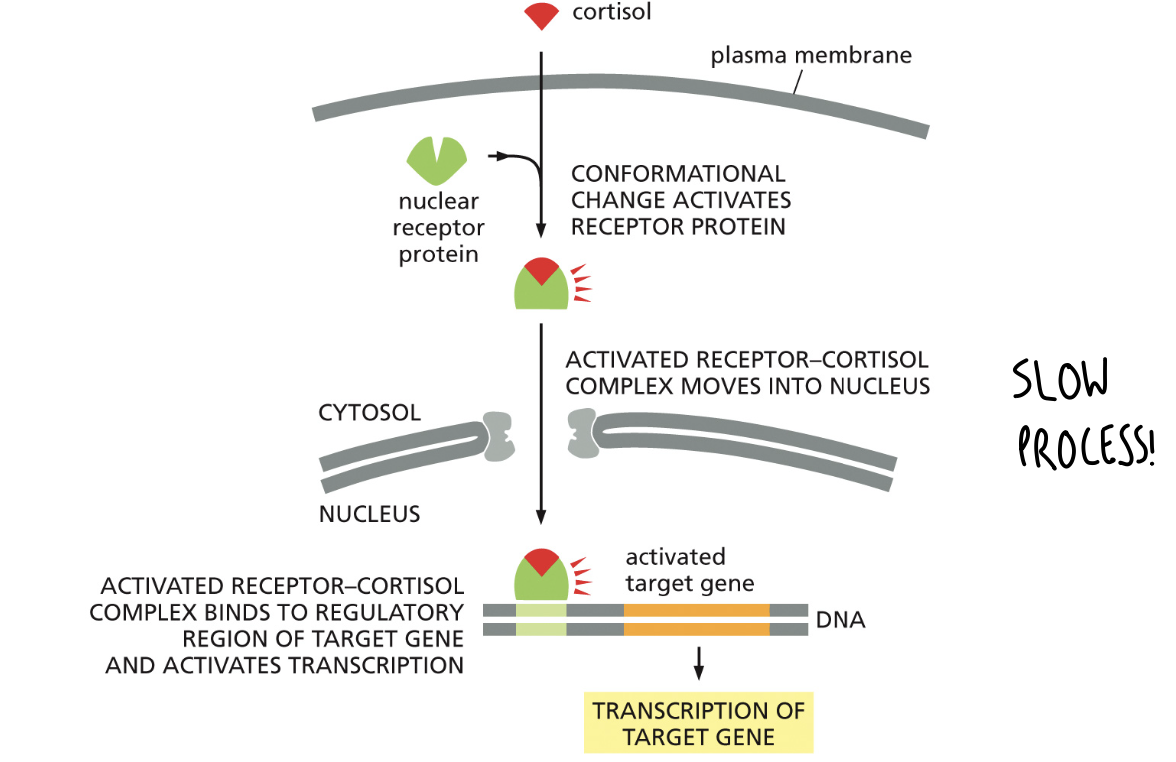
Cells are exposed to a wide variety of signals
cells of a multicellular organism are exposed to hundreds of signals in its environment
whether or not they respond to those signals depends on whether it posesses a receptor protein for that signal
the extracellular signal molecule alone is NOT the message: the information conveyed by the signal depends on how the target cell receives and interprets the signal
the same signal, acetylcholine will bind to different cells and induce decreased rate of firing, secretion or contraction
like me telling the same story to 3 friends—> different outcomes
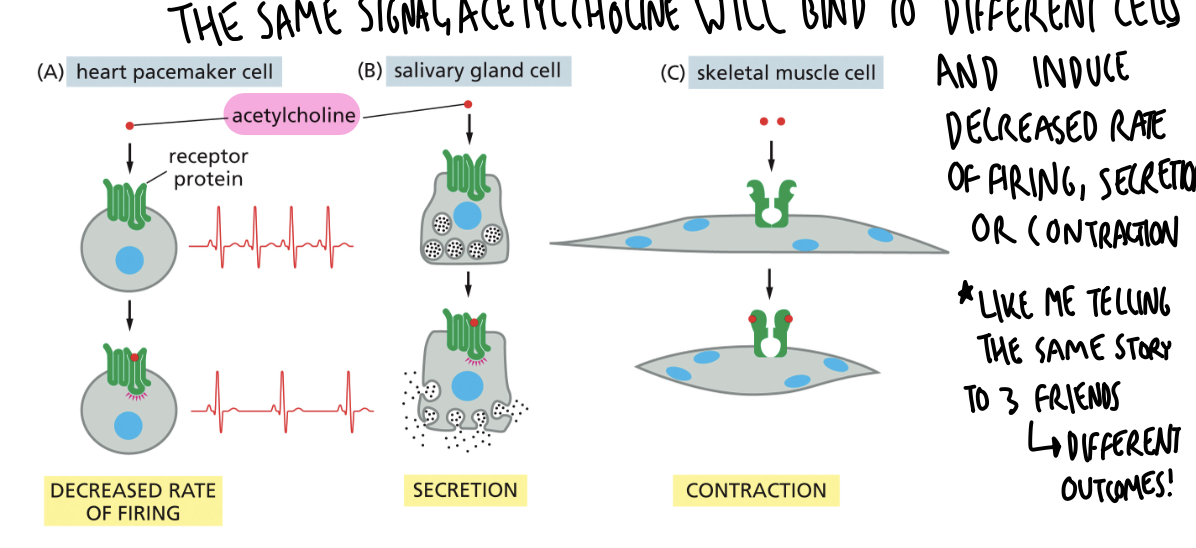
The same signaling molecule can exert different effects on different cell types
the same acetylcholine signal induces different responses depending on the cell type and receptor

Food for thought: combinatorial signaling
1) a cell in our bodies can be exposed to several hundred positive and negative signals at the same time-how do they coordinate appropriate responses and what happens if they don’t?
2) some signals function in a concentration-dependent manner-can and how do concentration differences elicit different responses?
3) responses to signals require the appropriate receptors that are expressed in a highly cell type-specific manner-how does a cell know to express the correct receptors?
Functional consequences of combinatorial cell signaling
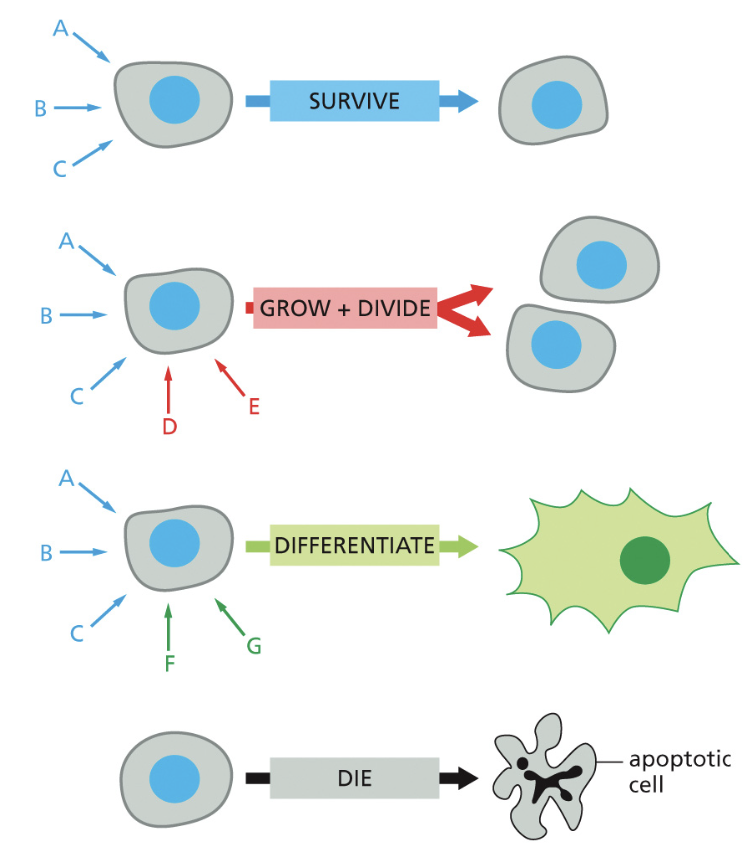
Cell surface receptors relay extracellular signals via Intracellular signaling pathways
the receptor protein performs the 1st signal transduction step: it binds the extracellular signal (primary messenger), and generates new intracellular signals (secondary messengers)
A “molecular relay race” is initiated as signals get passed “downstream” from one intracellular signaling molecule to the next, until the “response” of the cell has been completed
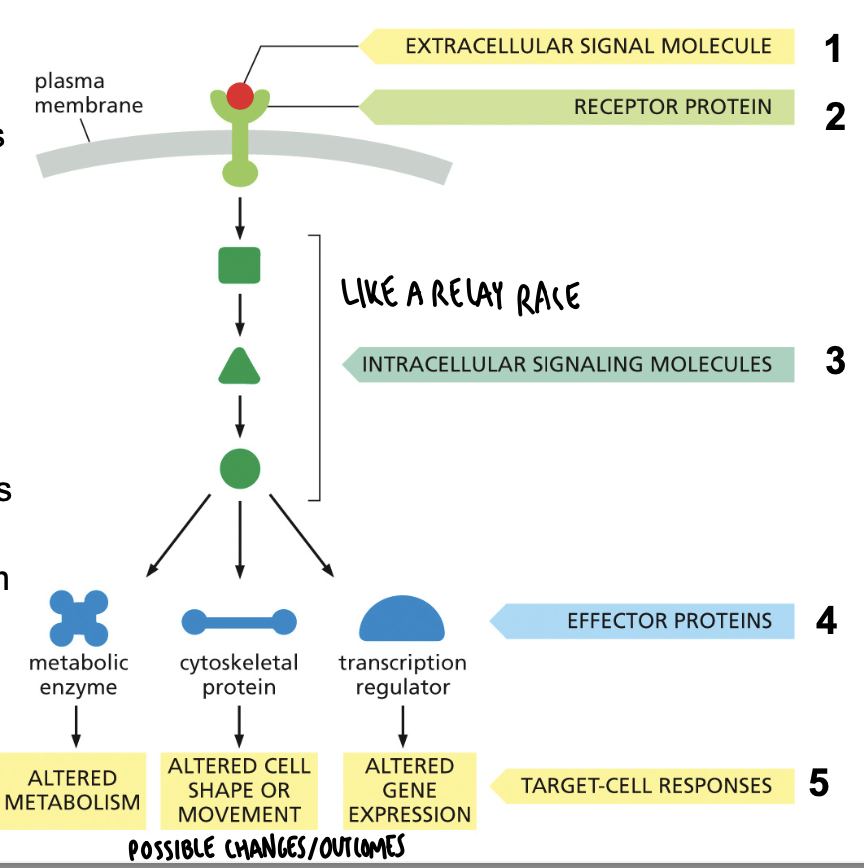
Signal transduction is relayed and amplified in the cytoplasm
intracellular signaling pathways perform one or more crucial functions:
(a) relay the signal onward
(b) amplify the signal received (make it stronger so that only a few intracellular signaling molecules can evoke a large intracellular response)
© receive signals from multiple intracellular signaling pathways and integrate them
(d) distribute the signal to more than one signaling pathway or effector protein
how is this achieved?
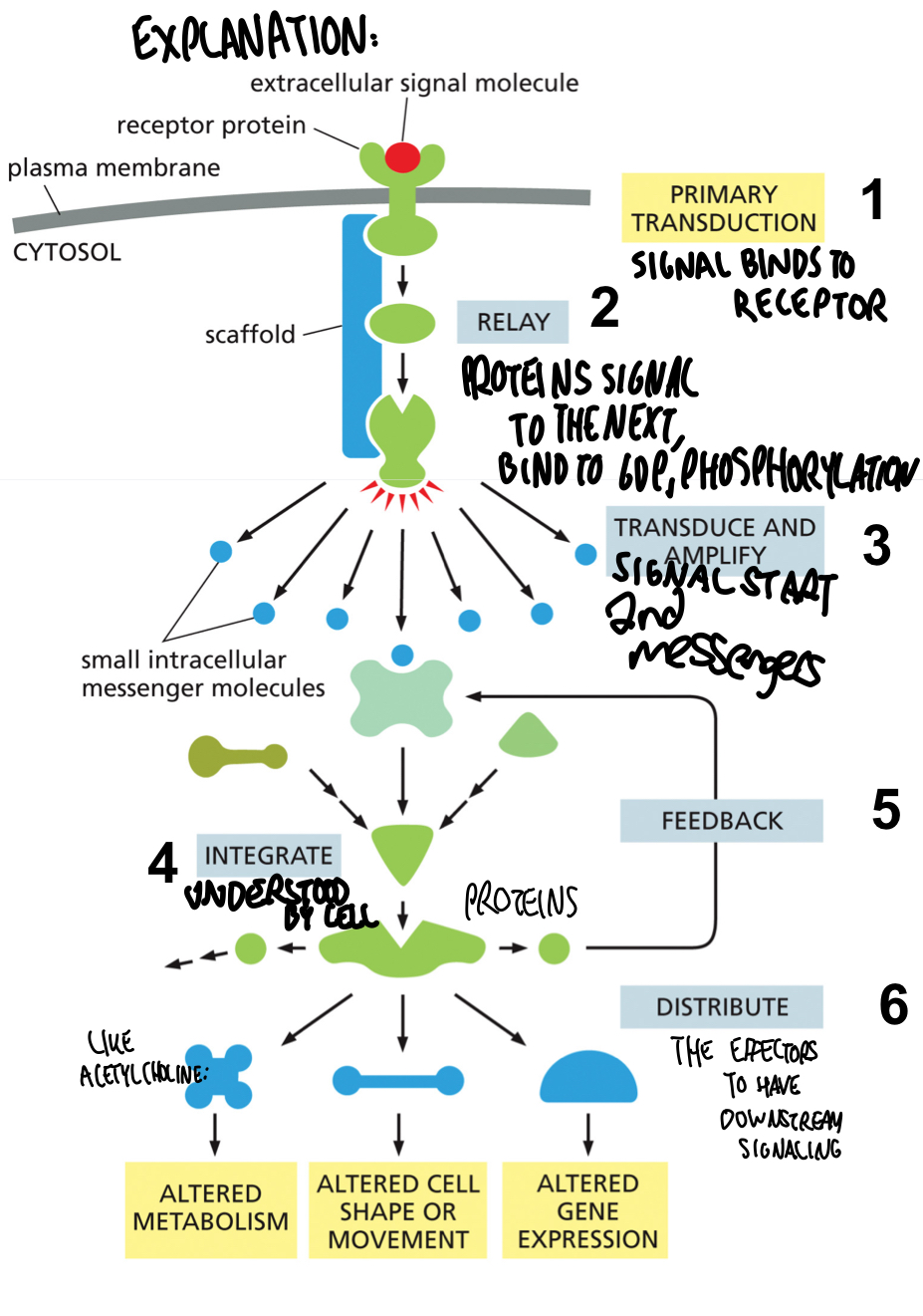
Signal transduction by phosphorylation and dephosphorylation
serine threonine kinases: p-Ser and p-Thr
Tyrosine kinases: p-Tyr
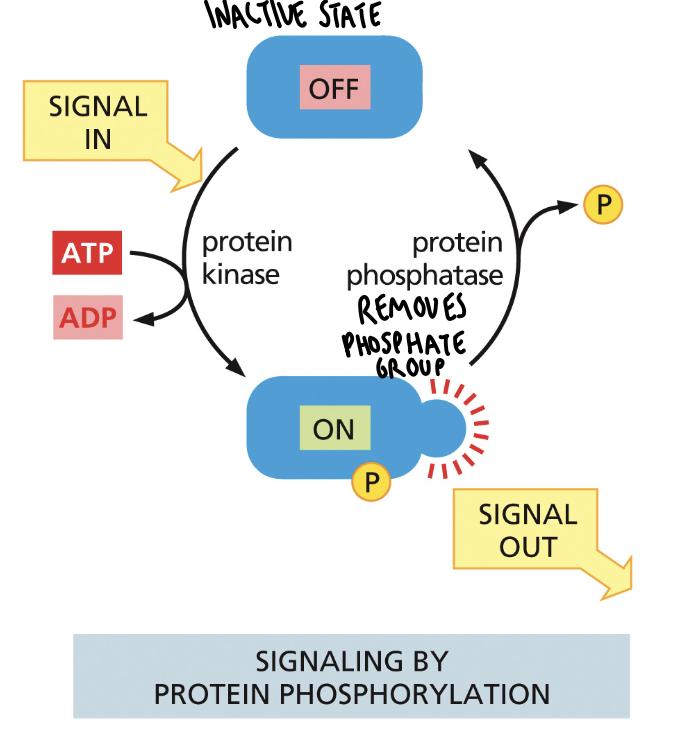
Signal transduction by GTP hydrolysis and exchange

Signal transduction by GTP hydrolysis and exchange
GEF=guanine nucleotide exchange factor
GAP=GTPase activating protein

Intracellular signaling proteins can act as molecular switches
molecular switches allow signals to switch between inactive and active states
Once activated, these proteins can turn on other proteins in the signaling pathway
they persist in the active state until another switch turns them off
kinases (phosphorylation of one protein activates phosphorylation of the next)
GTP-binding proteins (activation depends on whether or not GTP or GDP is bound)

Three general types of cell surface receptors
ion-channel-coupled receptors
G-protein-coupled receptors
C-enzyme coupled receptors
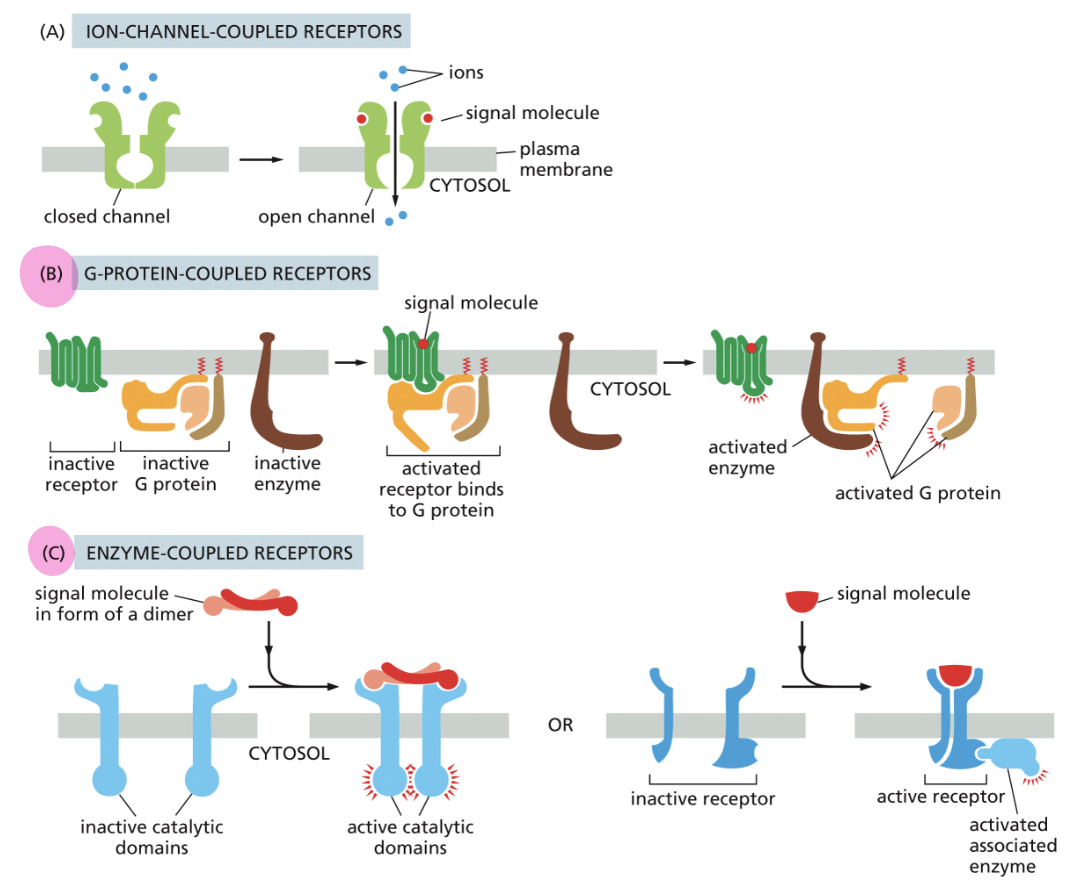
G protein coupled receptors (GPCRs): 7-pass transmembrane receptors and trimeric G protein
activates membrane-bound, trimeric GTP-binding proteins (G proteins), which then activate either an enzyme or an ion channel in the plasma membrane
each is composed of a single polypeptide chain that is a seven-pass transmembrane receptor protein (spans the membrane 7 times)
when bound to a signal molecule, the receptor protein undergoes a conformational change that enables it to activate a G protein on the underside (cytosolic) of the plasma membrane

G-protein-coupled receptors (GPCRs)
there are several varieties of G proteins, and each is specific for a set of receptors and target enzymes or ion channels
each G protein is composed of alpha, beta, and y subunits (on the cytosolic side)
these subunits are tethered to the plasma membrane by short lipid tails
in the unstimulated state, the alpha subunit has GDP bound, and the G protein is idle
When an extracellular ligand binds to the receptor, the receptor activates the G protein by causing the alpha subunit to release GDP, and exchange it for GTP
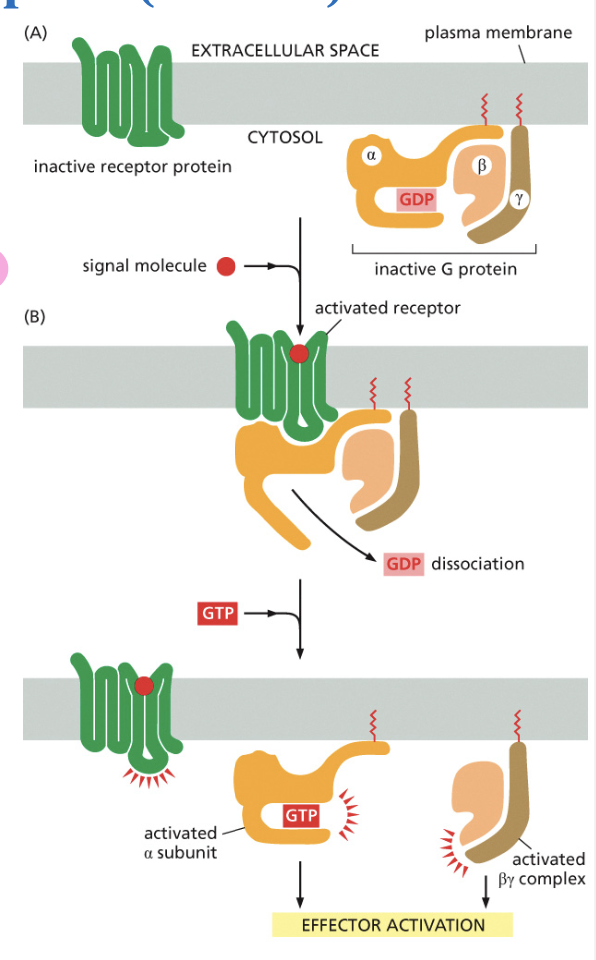
Ga subunit has intrinsic GTPase activity to turn off signal
alpha subunit has intrinsic GTPase activity, and ultimately, will hydrolyze the GTP back to GDP returning the G protein back to its inactive state
target protein activation—> GTP hydrolysis/target protein inactivation—>g protein inactive
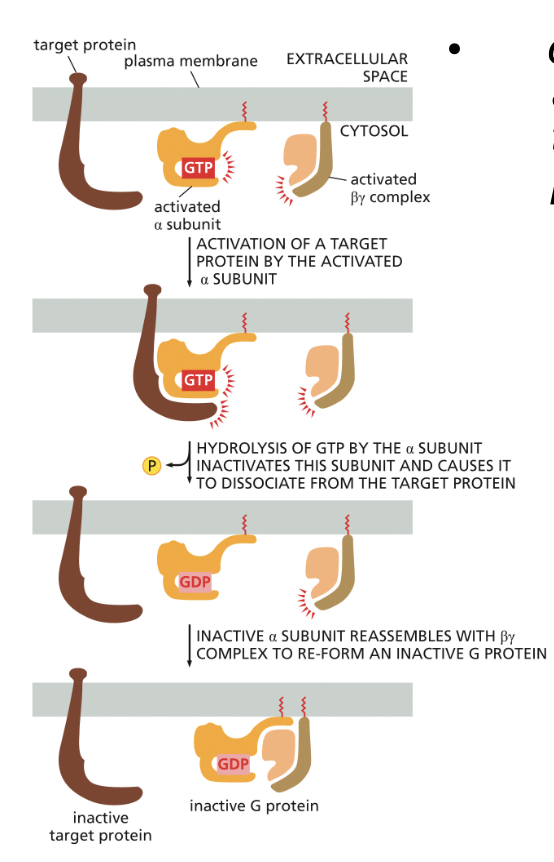
GPCRs can activate membrane bound enzymes
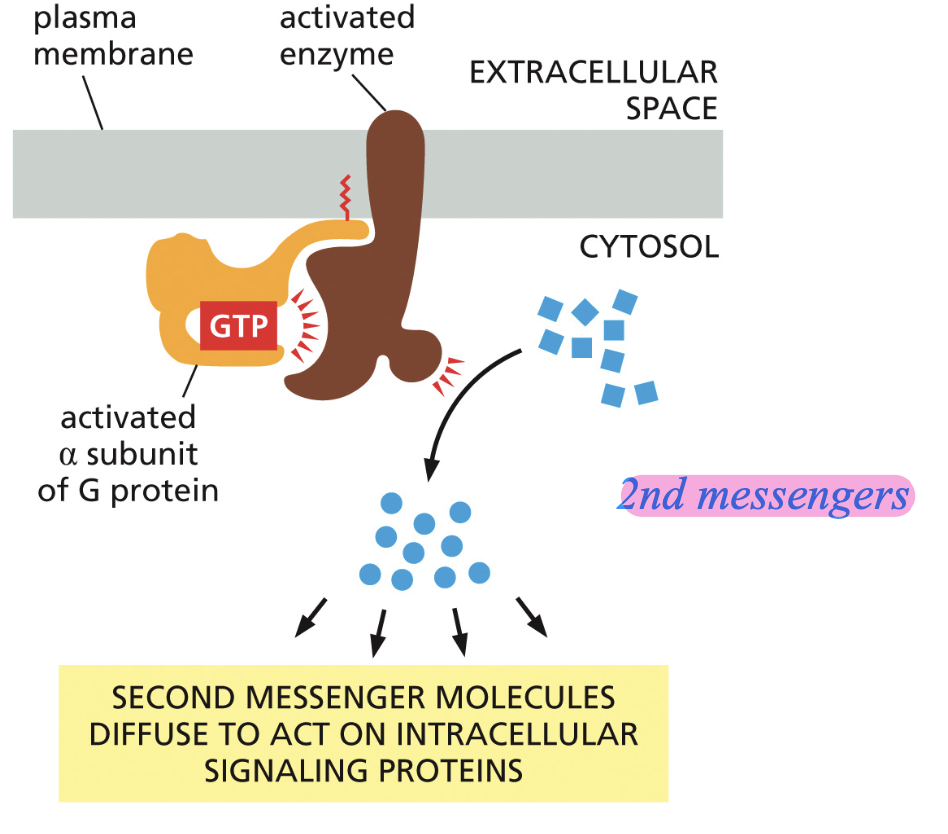
GPCRs can activate adenylate cyclase to increase second messenger cAMP
adenylyl cyclase produces cyclic AMP by removing 2 phosphate groups from ATP and forming a cyclic structure (breaking down glycogen in skeletal muscles for energy)
cAMP-cyclic AMP is a secondary messenger
pka-protein kinase A
activated pKa can regulate function of glycogen phosphorylase
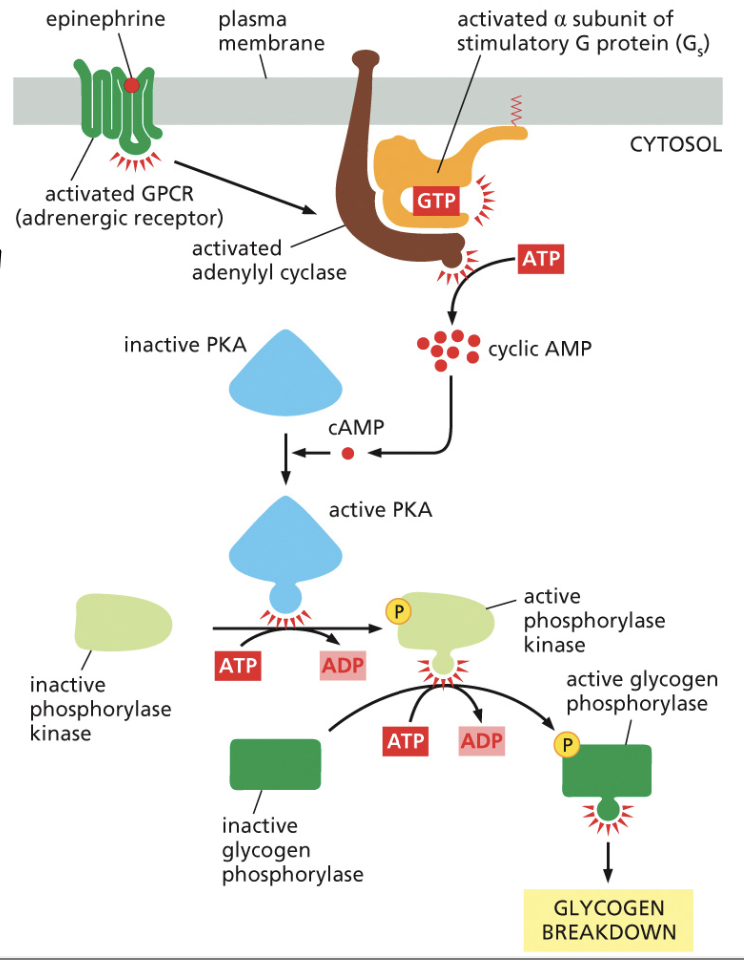
GPCRs can activate adenylate cyclase to increase second messenger cAMP
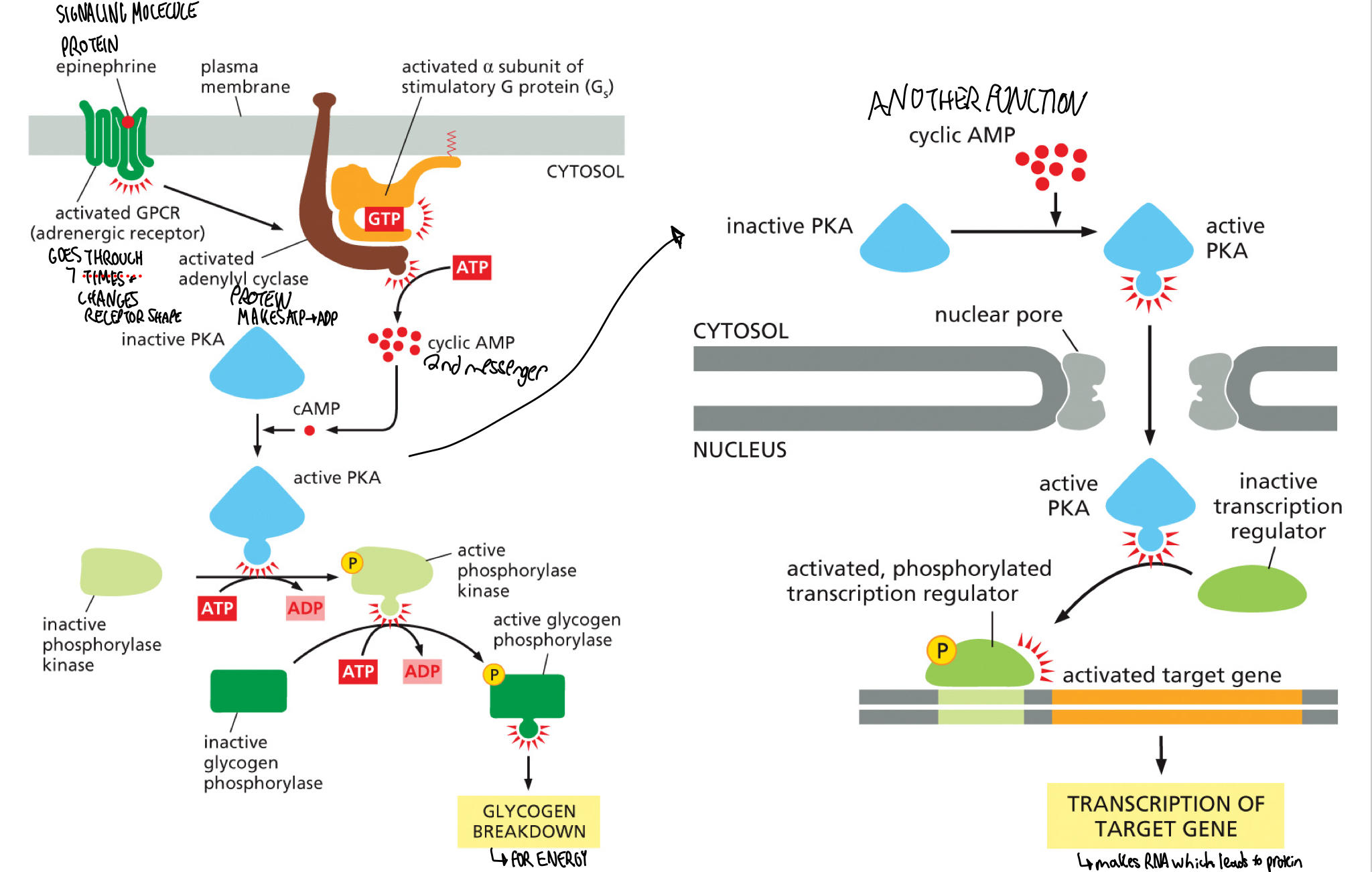
GPCRs can activate phospholipase C to increase second messengers IP3 and DAG
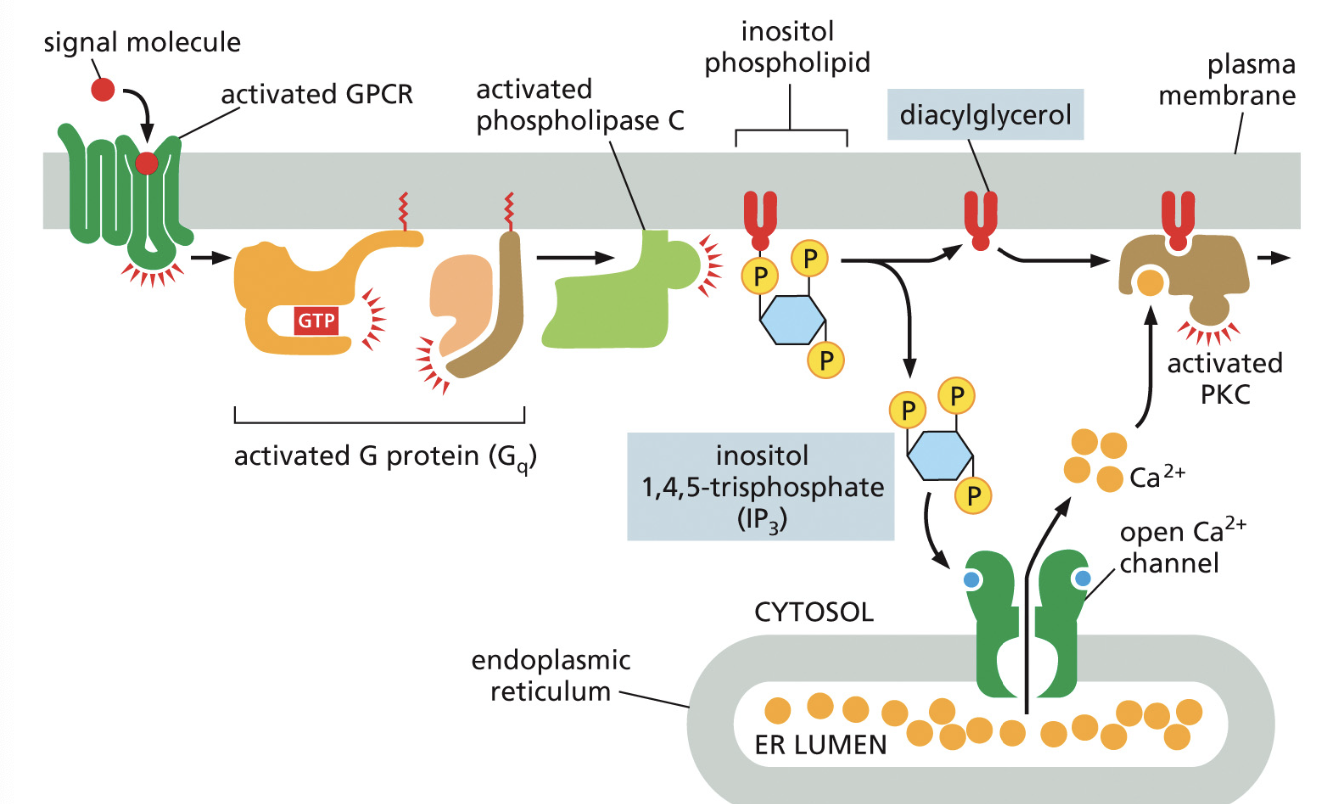
Enzyme-Coupled Receptors
like GPCRs, enzyme-coupled receptors are transmembrane proteins that display their ligand-binding domains on the outer surface of the plasma membrane
the cytoplasmic domain of the receptor either acts as an enzyme itself or forms a complex with another protein that acts as and enzyme
they respond to extracellular signal proteins (called growth factors) and regulate cell growth, proliferation, differentiation, and survival (typically slow response)
mediate and direct the rapid reconfigurations of the cytoskeleton and control cell shape and movement

Enzyme-linked Receptor Tyrosine kinases: phosphorylation cascades that lead to gene activation
RTKs are a large class of enzyme coupled receptors
RTKs contain a cytoplasmic domain that phosphorylates specific tyrosines on selected intracellular proteins
the binding of a signal molecule to the extracellular domain of an RTK causes two receptors to associate into a dimer
dimerization activates the kinases
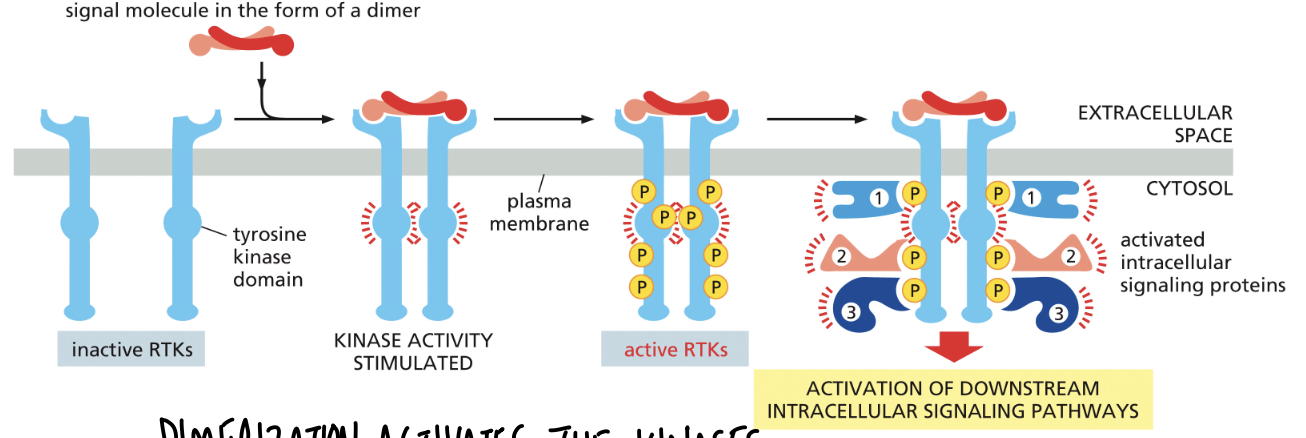
Activation of Receptor Tyrosine Kinases (RTKs) stimulates Assembly of an intracellular signaling complex
dimerization activates the kinases and enables them to phosphorylate their tyrosines
each phosphorylated tyrosine serves as a specific binding site for a different intracellular signaling protein, which relays the signal to the cell’s interior

The proto-oncogene Ras is a target of RTKs
Ras (oncogene)-a small GTP-binding protein that is bound by a lipid tail to the cytoplasmic face of the plasma membrane
Member of a large family of monomeric GTPases (resembles the alpha subunit of a G protein and acts as a molecular switch)
adaptor protein docks on a specific phosphotyrosine on the activated RTK and recruits Ras-GEF stimulating Ras to exchange its bound GDP to GTP
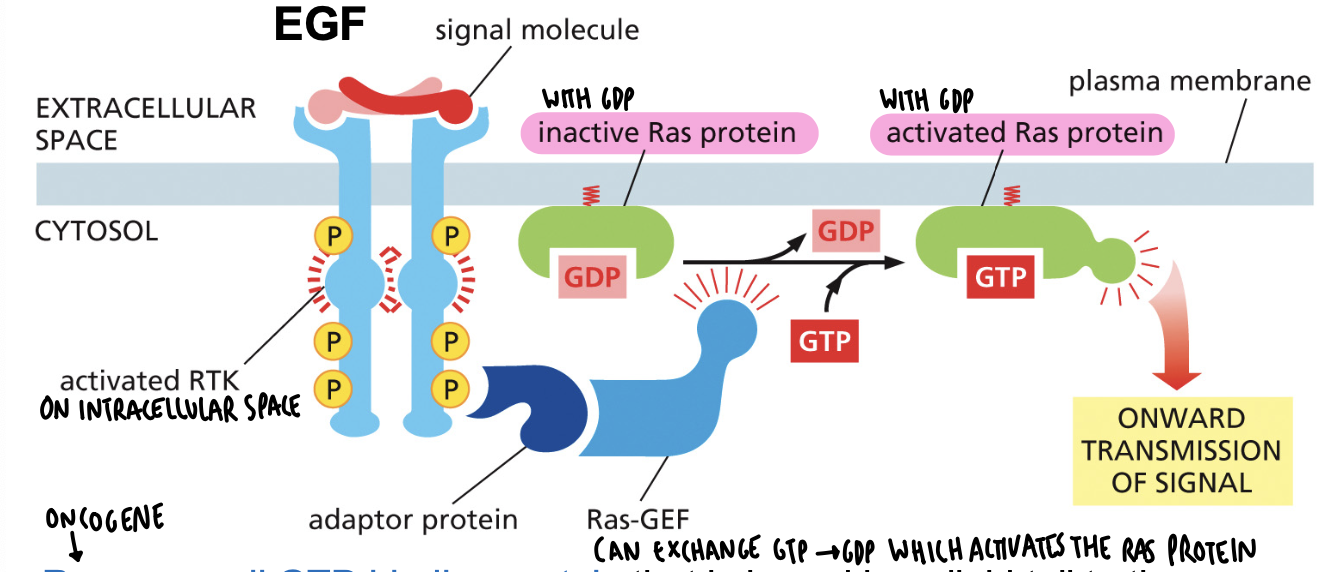
Activated Ras is mutated in 30% of human cancer
~30% of human cancers contain activating mutations in Ras genes, that inactivate RAS GTPase activity (unable to shut itself off)
in its active state, Ras promotes activation of a phosphorylation cascade-series of serine/threonine protein kinases phosphorylate and activate one another
Ras activates a MAP-kinase signaling molecule
MAPK phosphorylates various downstream signaling or effector proteins including other protein kinases, and transcriptional regulators that control gene expression
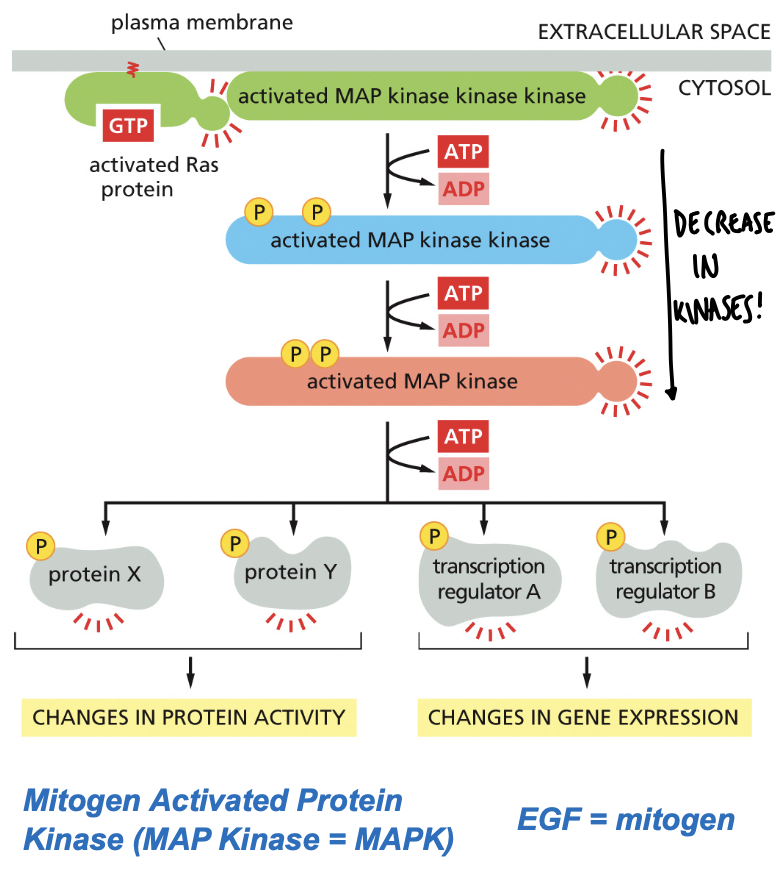
RTKs can activate the PI-3-kinase-Akt signaling pathway
insulin-like growth factor (IGF) is important for cell survival and proliferation and acts through RTKs
One crucial signaling pathway that RTKs activate to promote cell growth and survival relies on the phosphoinositide 3-kinase (PI 3-kinase)
PI 3-kinase then phosphorylates membrane-associated inositol phospholipid, which recruits a protein kinase-Akt that is activated by protein kinase 1 and 2

Akt (PKB) relays a survival signal downstream of RTKs and PI3K
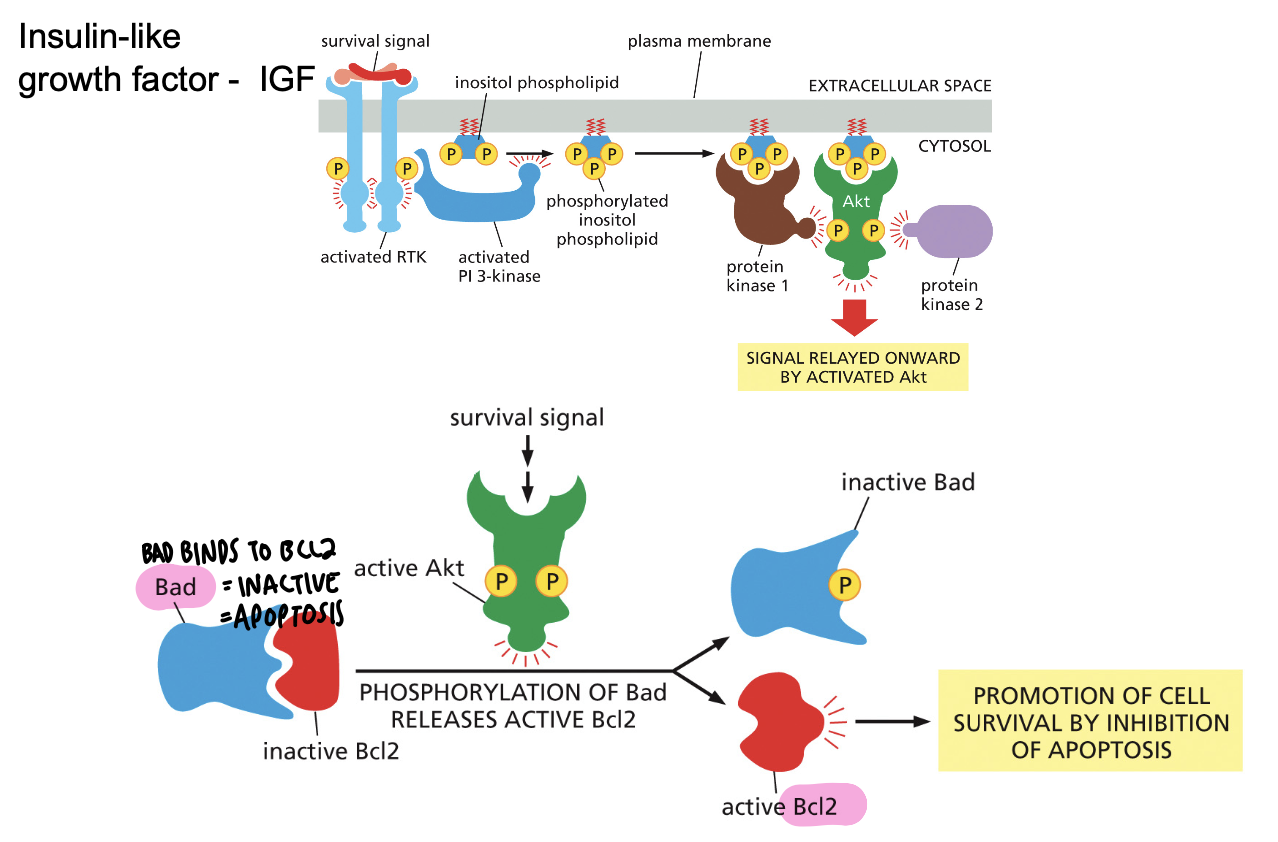
Akt stimulates cells to grow in size by activating Tor
PI-3-kinase-Akt signaling pathway also stimulates cell growth
Growth factor binding to RTK activates the PI-3-kinase-Akt signaling pathway
AKT indirectly activates TOR by phosphorylating and inhibiting a protein that helps to keep TOR shut down
TOR (is a serine/threonine kinase) stimulates protein synthesis and inhibits protein degradation
Disruption of TOR (controls cell size) signaling is associated with autism and larger brains in autistic patients
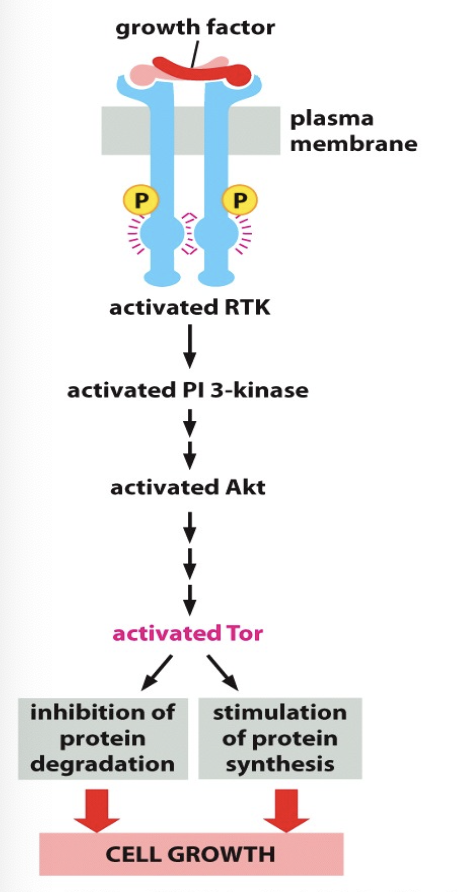
Mutant proteins can help determine…
exactly where an intracellular signaling molecule binds
to determine which tyrosine binds to a specific intracellular signaling protein, a series of mutant receptors are made
in the mutants shown are single tyrosines (Y2 or Y3). that have been replaced by an alanine
as a result, the mutant receptors no longer bind to one of the intracellular signaling proteins
the effect on the cell’s response to the signal can then be determined

A constitutively active form of Ras transmits a signal even in the absence of an extracellular signal molecule
the overactive mutant form of Ras, looses ability to hydrolyze GTP
Mutant Ras-GTP cannot shut down its activity and is constantly active
Continuous transmission of signal along multiple pathways in absence of extracellular signal molecule

Genetic analysis reveals the order in which…
intracellular signaling proteins act in a pathway

Genetic analysis reveals the order in which intracellular signaling proteins act in a pathway-RAS signaling
a hypothetical Ras signaling pathway can be shut down by a mutation in protein X
adding a continuously active Ras to cells with a mutation in X restores activity to the pathway, allowing the signal to be transmitted even in the absence of an extracellular signal molecule

Genetic analysis reveals the order in which intracellular signaling proteins act in a pathway-RAS signaling
by contrast, adding a continuously active Ras to cells with a mutation in protein Y fails to rescue, as Ras lies upstream of the blockage

Some intracellular signaling proteins serve to integrate…
incoming signal
Signals A,B,C, and D may activate different cascades of protein phosphorylation, leading to the phosphorylation of the target protein
the target protein is activated by phosphorylation at multiple sites and therefore active only when all the signals are simultaneously present
